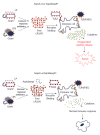Lack of new antiinfective agents: Passing into the pre-antibiotic age?
- PMID: 26322166
- PMCID: PMC4549771
- DOI: 10.4331/wjbc.v6.i3.71
Lack of new antiinfective agents: Passing into the pre-antibiotic age?
Abstract
The lack of newly developed antibiotics, together with the increase in multi-resistance of relevant pathogenic bacteria in the last decades, represents an alarming signal for human health care worldwide. The number of severely infected persons increases not only in developing but also in highly industrialized countries. This relates in first line to the most severe form of a bacterial infection, sepsis and the septic shock syndrome, with high mortality on critical care units. No particular anti-sepsis drug is available, and the therapy with conventional antibiotics more and more fails to provide a survival benefit. Due to the fact that the pharmaceutical industry has withdrawn to a high degree from the development of anti-infectious agents, a huge challenge for health care is approaching in the 21(st) century. In this article, these problems are outlined and possible alternatives are presented which may be helpful to solve the problem.
Keywords: Antibiotics; Antimicrobial peptides; Antimicrobial resistance; Cytokines; Endotoxins; Inflammation; Lipoproteins; Sepsis.
Figures




References
-
- World Health Organization. WHO Report on Global Surveillance of Epidemic-prone Infectious Diseases - Introduction. Available from: http://www.who.int/csr/resources/publications/introduction/en/
-
- Hughes JM. Policy and Politics in Nursing and Health Care (eBook). Mason DJ, Leavitt JK, Chaffee MW, editors. 6th ed. USA: Elsevier Health Sciences; 2014.
-
- British Broadcasting Corporation. Antibiotics resistance ‘as big a risk as terrorism’ - medical chief. [accessed 2013 March 11] Available from: http://www.bbc.com/news/health-21737844.
-
- Prevention and control of MRSA (bilingual) Available from: http://www.krankenhaushygiene.de/Nutzerdaten/File/empfehlungen/2010_rki_....
-
- Woodcock J. Re-Entering Antibacterial Drug Development Summit. 2015 Nov 16-18; Hilton Back Bay Boston, Boston, MA. Available from: http://www.healthtech.com/Antibacterial-Drug-Development/
LinkOut - more resources
Full Text Sources
Other Literature Sources

